Search: Sevens Standard Restart With Good Catch 3
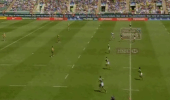
Sevens - Standard restart with good catch 3
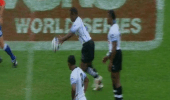
Sevens - Standard restart with good catch 2

Sevens - Standard restart with good catch 5
To watch over 2500+ videos join now for free!
JOIN NOW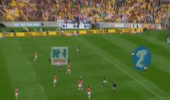
Sevens - Standard restart with good catch 1
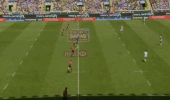
Sevens - Standard restart with good catch 4
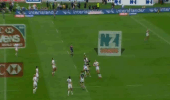 0:28
0:28
Sevens - Standard restart with attack winning ball 3
A well organised re start with one main attacker challenging for the ball with support both in front and behind him, if the ball is knocked either side of the main catcher the ball will be gathered by his teammates. Great leg drive to continue the attack and a very long pass to complete the scoring. Key factors : Accurate kick - Focus on the ball - Sideways jump - Catch ball above head - Structured support
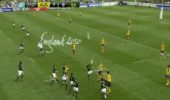
Women's - Standard restart with good catch
Women's - Standard restart with good catch
 0:20
0:20
Junior - Standard restart with good catch
Junior - Standard restart with good catch
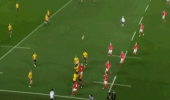 0:21
0:21
Men's - Standard restart with good catch 2
Men's - Standard restart with good catch 2
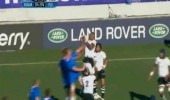 0:19
0:19
Men's - Standard restart with good catch 1

Sevens - Good contact body position/ball presentation 3

Sevens - Standard restart with attack winning ball 2

Sevens - Standard restart with attack winning ball 1
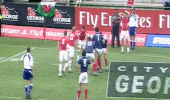 0:38
0:38
Sevens - Full Lineout 3
Accurate skills are the key to lineouts in seven's, a combination of movement, lifting and throw combine to make an effective restart for the attacking team. The shape of the attacking side is pre planned to create a mis - match with a faster player v a slower one. key factors : Pre call the move - Fast feet - Strong core for jumper - Support from both players to lift the jumper - Jumper to jump - Accurate throw - Support he jumper to the ground - Offload pass to scrum half
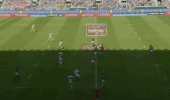 1:14
1:14
Sevens - Patterns of Play 3
Working in units and working through phases is crucial to modern day sevens and in this clip the White team show great technique and patience to work their way up the field to score. Key factors : Ball retention - Communication - Work in units - Accurate passing - Patience - Stamina
 0:42
0:42
Sevens - Wheeled Scrums 3
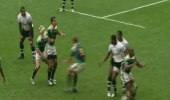 0:24
0:24
Sevens - Lineout catch & maul drive
Sevens - Lineout catch & maul drive
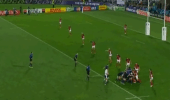 0:23
0:23
Men's - Lineout maul good defence 3
Men's - Lineout maul good defence 3
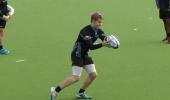 4:16
4:16
Catching is the First Skill of Passing
Being able to catch is fundamental to rugby and the majority of sports. Catching in rugby is slightly different due to the shape of the ball and understanding the technical points of "How to catch" is a very important area for all young players. This clip explains some of the finer points and why a good catch is the basis of a good pass
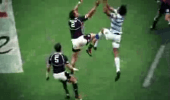 4:10
4:10
Sevens - Uncovered - The Aerial Battle
Re - starts are as numerous as scrums in seven's and coaches should put as much emphasis on the kick off as any other facet of the game. Possession is crucial in seven's and an effective re - start strategy can win not only matches but tournaments for teams. You must posses players who can kick and contest the ball in the air becasue if not you will be competing without the ball for long periods of the match. Listen to the top coaches on how important they think the kick offs are
 0:36
0:36
Sevens - Short Restart 1

Sevens - Good contact body position/ball presentation 2

Sevens - Classic Tackle 3
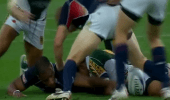
Sevens - Good contact body position/ball presentation 1
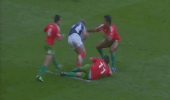
Sevens - Turnovers and move the ball 3
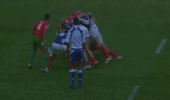 0:28
0:28
Sevens - Straight Scrums 3
Good Practice - Segment 3
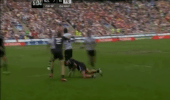
Sevens - Offloads 3

Junior - Good contact body position/ball presentation 3
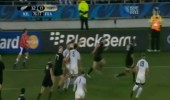
Men's - Standard restart with attack winning ball

Women's - Standard restart with attack winning ball

Junior - Standard restart with attack winning ball 2

Junior - Standard restart with attack winning ball 1

Sevens - Short Restart 2
Step 5 - Introducing the 3 v 3 Scrum
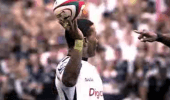 3:55
3:55
Sevens - Uncovered - The Playmaker
This footage outlines the importance of "decision making" in seven's. The top sides have players with a variety of skills but to be consistent performers teams require a playmaker who has the vision and tactical acumen to manage team tactics "On the move" and the ability to create opportunities out of nothing
 4:48
4:48
Tips for Coaching Sevens Rugby
Sevens expert Russell Earnshaw talks through his coaching philosophy and approach to drills, exercises and games
 3:24
3:24
Sevens - Uncovered - The Sevens Referee
Sevens - Uncovered - The Sevens Referee
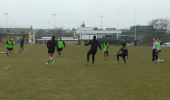 2:59
2:59
Quins Defence - Tackling in units 3 v 3
This exercise is part of a tackle technique progression and pitches 3 attackers v 3 defenders. As in match play the attacking players will present different challenges to the defenders. The coaches can choose to alter the conditions to put more or less pressure on the players
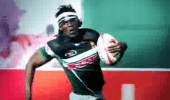 3:50
3:50
Sevens Uncovered
Sevens Unccovered
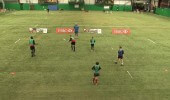 0:28
0:28
3 v 1 in Channel
A progression from the 2 v 1, where a second pass is encouraged to move the ball away from the defender.
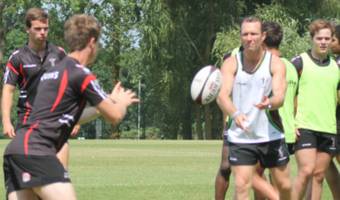 3:05
3:05
3 v 2 How to Fix Defenders
Running straight & fixing defenders is a skill that all players must learn and learn at an early age. The top players regularly practise this skill to maintain accuracy. This is the building block to scoring tries
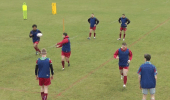 5:41
5:41
Catch & Pass Progressions
Passing progressions are based upon the ability of players to fix defenders. Always insure your exercises reflect match situations and refrain from just doing drills because they look good
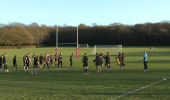 2:02
2:02
Broncos 3 - Develop waves of attack
The first wave of attackers identify space and punch through the first line of defence. The ball carrier looks to move the ball quickly and away from covering defenders. This exercise tries to copy game situations as players cover their team mates in defence
 2:22
2:22
Restart Attack
Here are some examples of good use of the restart in attack to help you in your coaching process
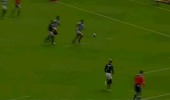
Sevens - 2 v 1
Seven's is about creating chances and then taking them. In this clip the Blue team take the ball up the middle of the pitch to draw in defenders, after recycling the ball they have a 2 v 1 opportunity, a straight line of running and a flat wide pass creates the try. Key factors : Call early - Run straight - Wide spin pass - Catch and swerve to score
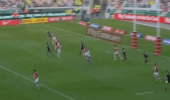 0:26
0:26
Sevens - Strike Moves 2
Players can strike from any location on the pitch, in this clip the Red team relax thinking they have the attackers behind their own posts, however a strong scrum, good pass and great step create the gap to go through, the next 95 metres is all about speed and fitnes. Key factors : Space beetween attackers - Good pass - Side step - Speed - Stamina
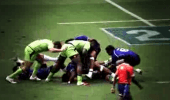 3:52
3:52
Sevens - Uncovered - The Breakdown Specialists
The breakdown has become a significant area for coaches and players to focus on. All players now need the technical skills and the intensity to compete at the tackle area and if players are poor in this area teams will be exposed. Some teams will select a specialist in this area and combine his skills with tackle technique from other players so that they work in units to turn over possesion
3. Half Back Play Continued
A scrum half needs good vision, speed and awareness, quick hands and lightning reactions. The scrum half is the key link between the forwards and the back line. A good scrum half will know how to vary the play and take advantage of any opportunity that the opposition may offer
The fly half is the heart beat of the side and should be a key influence on the way the team plays the game. Almost every attack will go through the fly half, so they need to develop tactical awareness, accurate passing, kicking accuracy, vision, leadership and resilience
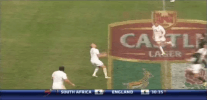 0:44
0:44
Catch and Pass
Here are good examples of catch and pass to assist you in your coaching process
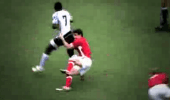 4:15
4:15
Sevens - Uncovered - Defence
The leading international coaches explain why defence is so important and how much emphasis they put on it. This clip features a variety of tackles and techniques and post good defence the opportunity to turn the ball over. Most coaches will use a system for their defence and here are some insights
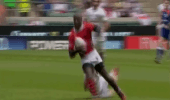 0:37
0:37
Sevens - Classic Tackle 1
Good tackle technique when chasing a player from behind. The defender gets to his feet quickly to contest the ball. Key factors : Head to one side - Arms around attackers waist and slide down - Keep your arms around the attackers legs - Use momentum to get back to your feet
Step 3 - Introducing the 1 v 1 Scrum
 2:59
2:59
USA Sevens - Techniques For Contact
Retaining possession in Seven's wins matches, it's that simple but these days you need to improve your contact skills. Phil Greening provides a few tips and some insight into some of the USA's training drills
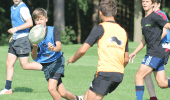 4:24
4:24
Catch and Pass Basics
Northampton saints academy manager Ross Stewart outlines why the basics are so important and runs through some simple techniques
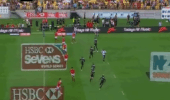 0:24
0:24
Sevens - Strike Moves 1
A simple but effective attack from a scrum. Three good passes provides the winger to run past his defender to score. Notice how the first reciever is directly behind the scrum and not to the side, (This makes the pass from the scrum easier when under pressure). Key factors : Position of 1st reciever - Run straigh and wide spin pass - Speed of the runner
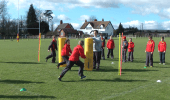 1:16
1:16
Passing - 3 v 2 Static Defenders
Progress to working in 3s against two static defenders. The pressure is on the middle player to hold their depth and perform a quick pass.
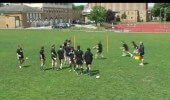 0:33
0:33
3 v 2 in channel
A good progression from the 2 v 1 drill
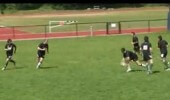 0:13
0:13
Attacking in waves of 3
The ability to realign quickly is important to developing the back play and counter attacking. Coaches can vary the numbers and timing of the first pass to make this exercise easier or more demanding. Key factors : Run straight - Comunicate early - Uniform distance and depth - Catch & pass in one movement - Hips straight - Hands & armes across the body - Realign quickly - Aerobic fitness
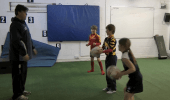 2:59
2:59
Home Training - Fun Catching & Passing Games
A variety of drills and games to practice and improve your catching & passing
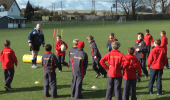 2:15
2:15
Passing - 3 v 2 Live Defenders
Gradually progress from 2 static defenders, to 3 v 2 roaming defenders. The first two players must draw their defenders before giving the pass.
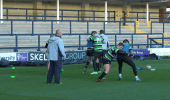 5:13
5:13
How to coach the Catch or Choke Tackle
Some of the latest ideas around tackle technique and what defenders are trying to achieve. This session provides the technical progressions needed to teach the choke / catch tackle
 7:19
7:19
Sevens - Uncovered - The Support Staff
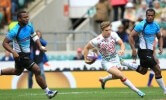 3:32
3:32
England Sevens - Tom Mitchell - Conditioning Circuit
7s training
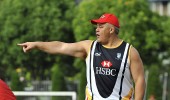 4:31
4:31
Sevens - Uncovered - The Coach
What is the role of the coach. In this clip some of the top 7's coaches give some thoughts on what they do and how they see themselves in the make up of the modern 7's squad
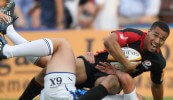 3:32
3:32
England Sevens - Marcus Watson - Trunk Circuit
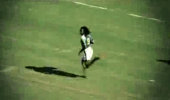 5:19
5:19
Sevens - Uncovered - Attack
Elite coaches discuss their attacking philosophies and this underpines the skills and techniques they will work on as coaches and the type of trainign sessions they will plan. As a coach how do you coach the skills that the Fijian players possess or the patience the Welsh side had to win the last 7's world cup. Does the team represent the ideas and plans of the coach?
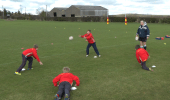 1:14
1:14
Catch Up Passing Game
A quick handling game to warm up. Handy if there's a few players standing around at the beginning of a session, waiting for others to turn up.
 2:56
2:56
USA Sevens - Creating Habits Through Collision Conditioning
Perfect practise is about replicating match conditions in training. Phil Greening outlines his approach and provides some practical examples
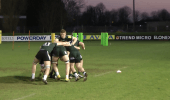 1:40
1:40
Lineout Catch-and-drive
Lineout catch and drive drill
 1:29
1:29
Andy Farrell's 3 Top tips For Defence
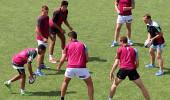 2:07
2:07
Fun Catching Games
There's often down time before a training session where you can't help butthrow a ball around. Why not try out these fun games that will work your core skills as well. They work great as a gentle introduction to a session to switch players on.
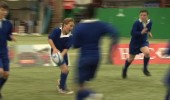 0:26
0:26
3 v 2 in Channel
A development of the 2 v 1 and 3 v1 drills, the attackers now must beat 2 defenders. This requires more decision-making ability as the movements of the defenders could change every time. Players must communicate as well as continue to perform their handling and running skills.
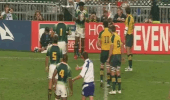 0:31
0:31
Sevens - Full Lineout 2
Sevens - Full Lineout 2
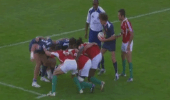 0:31
0:31
Sevens - Wheeled Scrums 1
A strong scrum can be a great weapon for attack in seven's, in this clip the Red scrum puts pressure on the defending loose head (Right hand prop) which wheels the scrum and allows the defending scrum half to disrupt the ball forcing a turnover. Key factors : Tight binding - Low body position - Leg drive - Working as a unit
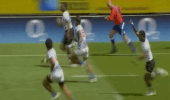 0:58
0:58
Sevens - Offloads 1
Sevens - Offloads 1
Scrum Factory - 3. TOP With Rugby Balls
Expensive training equipment is not necessary and the simple rugby ball can provide an excellent technical and conditioning work out
Tackle technique 3
3. Ruck Touch
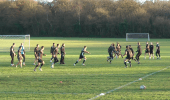 1:43
1:43
Broncos 4 - 6 v 3 Identify space
Players to attack with "Heads up" and identify where colleagues have space. Supporting players to call early to the ball carriers. Defenders to stay tight to not let attack through the middle spaces easily
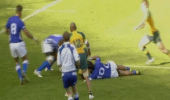 0:59
0:59
Sevens - Turnovers and move the ball 2
A turnover from a strong tackle and quick "Jackle" where the defender uses the momentum of the attacking player to swimg up onto his feet and contest the ball, this results in a line break. Key factors : Tackle technique - Urgency to get up to feet - Core strength - Speed
Good Practice - Segment 1
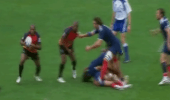 0:34
0:34
Sevens - Turnovers and move the ball 4
From a turnover in contact the attackers pass the ball wide one way and then a deep wide pass back in the other direction to pull the defence out of shape and create an opportunity to attack. Key factors : Wide flat pass - Players support from depth - Deep wide pass - Running and swerving past the defender
 3:23
3:23
Seven's - Speed Training
See some of the exercises the England 7's players go through for fitness & speed
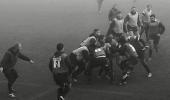 1:02
1:02
Lineout Catch & Drive
Premiership Rugby coaches and players highlight the importance of the lineout as an entry point and an attacking platform. Join PremiershipRugbyCoaching.com for ideas and examples to improve your lineouts.
3. Chain Tig
Scrum Factory; Examples Of Good Practice
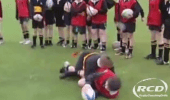 1:00
1:00
Introduction to tackling - Step 3
Repetitive exercises can help players become familiar with tackling technique.
Good Practice - Segment 4
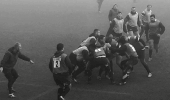 1:08
1:08
Building the Catch and Drive
The driven lineout is an increasingly effective attacking platform. Here is a quick preview of some of the exercises and advice available on Premiership Rugby Coaching. Join now to see more.
 0:23
0:23
Men's - Patterns of play 3
Coaching 7-a-side Rugby - Restarts; kicking short
As possession is king, gaining possession from a kick off is vital for effective 7s. Especially considering that the team that scores takes the kick off.
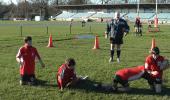 0:37
0:37
Tackling on Knees - 3 v 1
Using three attackers ensures the defender tackles on both sides and from slightly different angles. The coach can vary the pace and width of this exercise
Tackling 3 - Hunting a Tackle
Tackling - Hunting a tackle
 2:06
2:06
L2 - Kicking Development
Skill Practice Description • The teams start with kicking netball i.e. the kicker cannot run and cannot be interfered with. • The player with the ball kicks to work the ball up field and a clean catch behind the goal line is 1 point • Other ways to score are by a drop goal awarding 3 points. • If a breakdown occurs the coach can award a free kick. • The ball carrier can choose to kick to a team mate or try for a target. • The targets can only be aimed at when the targets are in the other half of the pitch. • If the target is missed, possession goes to the other team. • Progression; the kickers must be ‘running’ when kicking the ball. • They must kick within 5 - 8 metres of running. They cannot just keep running with ball in hand. • Players can chip and catch for themselves. • This gives more opportunity for free kicks to be awarded through breakdown in play. • Allow players to discover personal techniques of kicking with both right and left foot. Punt, • Grubber etc. • Discourage throwing the ball up and develop the drop. • Identify those with consistently low outcome percentages and address the relevant technical factors
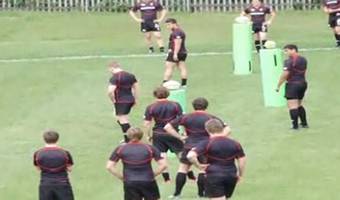 2:53
2:53
L2 - Conditioning Circuit
Using the full length of the pitch the practice is a continuous 3 v 2 scenario. • 3 attackers knock over a bag to collect a ball and attack 2 defenders in the 5m channel. • If they fail to beat the defenders (touch/grip), the attackers run back to knock over another bag and start again. • Having beaten the first defenders they carry on with the same ball to beat 2 further defenders who may choose a colour and start from the appropriate cone. • If the attackers fail to beat the defence they run back to the bag and start again with another ball. The defence can choose another colour to start from. • The next challenge is two free roaming defenders. If the attack fail they go back and knock over another bag to start again. • Finally the defenders choose a colour to start from and if the attack fail they get another ball and the defence choose another starting colour. • The objective is to complete the attack with the starting ball and restarts. Keep score to create competition
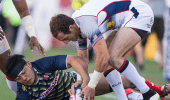 2:18
2:18
USA Sevens - Learn The Rules Of The Ruck
With less players the breakdown is much cleaner in Seven's and knowing the laws and being accurate in your skills wins matches. Mike Friday clarifies what can be a complex area and why many coaches focus on this facet of the game
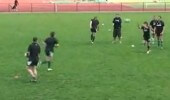
Passing 4 v 3 reset
A progression from 2 v 1 , 3 v 2 to 4 v 3
 0:18
0:18
Men's - Short restart
Men's - Short restart

